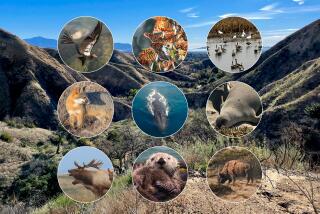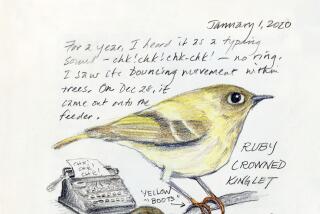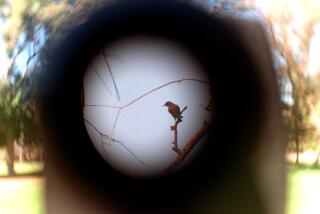How I Learned to Love the Ruby-Crowned Kinglet
In Palm Springs for a weekend of hiking, my husband, Tim, and I decided to take our first trip to the Salton Sea. The day did not begin well. We got off to a late start, it was way farther than weâd figured and, when we arrived, the scrubby lunar landscape and eerie silence did nothing to lift my spirits. Colonies of Hitchcockian birds hulked on banks of dirty sand and, in the distance, generator stacks spewed plumes of noxious-looking smoke.
I like to be hard on the trail by 9 a.m., but it was already past noon when we reached the eastern shore, saw a little brown sign reading âWister Wildlife Stationâ and turned off the main road. After 45 more minutes of jouncing through ruts of wet mud, we finally came upon a ranger station and stumbled inside.
More birds come to the Salton Sea than any other place in the United States except somewhere in Texas, the information lady told us, but this did not cheer me up. I like birds as much as the next person, but I am way too hyper to have even remotely desired to make a science of them. Besides, I didnât want to watch birds; I wanted to hike, and the only available trail was a dinky path that followed a narrow, water-fringed spit and looked about half a mile long.
âThree hours of driving and 30 minutes of fun,â I told Tim forlornly as we started off, thinking that if we walked fast enough, maybe we could do the loop twice. That was when we ran into Bob Miller, gazing raptly into a patch of reeds at the edge of a marsh. Bob was tall, with a sun-reddened face and a drooping mustache. A pair of binoculars swung from his neck, and in front of him stood a folding telescope. âSeen anything interesting?â he asked as we approached. He looked like a nice enough guy but I was in no mood to chat.
âWeâre not really bird people,â I said quickly. âWeâre just out for a walk.â
âIâve been out birding every day this year,â Bob reported and, when I raised an eyebrow, added, âCourse itâs only the fifth of January.â
âHa-ha,â I said, backing away. âWell, have a good time! Bye!â
âEver seen a double-crested cormorant?â he replied. âThey look black, but those feathers are really iridescent green.â
âMm,â I said, casting a perfunctory glance in the direction of his pointing finger. âWell, thanks a lot. See you later.â
âCheck out those green-winged teal, they look like theyâre in a conga line!â Bob exclaimed, nodding toward a shallow inlet on the opposite side of the trail. He was so full of enthusiasm it seemed rude to just walk away. After heâd showed us a pale gray-brown duck called an American wigeon and a few fierce northern harriers, also known as marsh hawks, Tim and I exchanged a what-the-hell-the-day-is-shot-anyway look, shrugged our shoulders and, like pilgrims surrendering to a guru, gave ourselves up to Bob.
Bob was a window into a parallel world of obsessive folks Iâd never known existed. A native of the area, he had been bird-watching since sunup (it was now almost 2 p.m.), had identified 67 species on that day alone and, in his life, had seen 299. This was not many for a birder, he told us. (There are approximately 8,700 species, according to Encyclopedia Britannica.) But it wasnât bad for someone who had never traveled. As it turned out, Bob was on a bit of a pilgrimage himself; he was hoping to see his 300th species of bird that very day.
Bobâs movements were deliberate and his voice was low, as if heâd spent a lot of time around creatures he didnât want to startle. While we trailed dutifully behind, he told us the difference between a snow goose and a Rossâs goose (the snow looks like it has lips, while the Ross has warts above its nose). He explained that rails are so shy you hardly ever see them. He described the loggerhead shrike, which impales crickets and lizards on barbed wire fences to die in the sun and returns to eat them later.
He pointed out lesser scaups and eared grebes, black phoebes and herring gulls, carefully noting each one in his little spiral notebook. He described the eating habits and mating habits and migration patterns of the different birds, and he said he could watch the way their neck feathers glistened in the sun all day and never get bored.
Every time I tried to pick up the pace a little, Bob called me back.
âYouâll like this one,â he said, moving aside to let me look through his telescope. âThis is a ruby-crowned kinglet.â Its white eye-ring and red-splotched head were captivating, but I wondered where Bob found the time. âDonât you . . . work?â I asked.
âNot anymore,â he replied. âDrove a truck all my life, but last year my rig jack-knifed--freak accident, lucky to be alive--and I broke a couple of vertebrae in my back.â He got a faraway look in his eyes. âEven carrying a telescope makes me ache now, and it may be just a pipe dream, but someday Iâd like to have a little bird-watching business of my own.â
The trail ended on the summit of a small hill. As we gazed over the silvery sheen of water, Bob described a birder from San Diego, an older fellow who couldnât see too well but had an uncanny ability of distinguishing birdcalls. Heâd be with a bunch of other birders facing, say, south, and suddenly heâd extend his arm behind his back, point due north, and announce, âYellow-rumped warbler!â Everyone would turn around and, sure enough, there would be the only yellow-rumped warbler anyone would see all day, winging across the sky.
As we walked back, Bob told us about the rogue painted redstart that had been hanging around the Brawley cemetery, and I realized Iâd stopped looking at my watch. In the end, it took us 2 1/2 hours to walk two miles, but by that time I was so absorbed by the wonders of the bird world that instead of fretting about my âwastedâ afternoon, I was scheming how I could buy a $1,000 telescope just like Bobâs.
Back at headquarters, we thanked him profusely and shook hands all around. He offered to buy us a soda pop, but we told him we had a long drive ahead of us and had to get going.
âIf you ever want to get in touch, Iâm in El Centro,â he said. âBob Miller, but itâs under Robert.â
As we headed back to Palm Springs, I pondered how Bob had managed to transform the whole day. That morning, I would have described the Salton Sea as salt-rimmed banks of mud marred by bulldozer tracks and the smell of raw sewage. Now the water was blanketed in mist and, every so often, the sun broke through, reflecting on the water in pools of molten gold.
âItâs beautiful here,â I breathed in surprise, and put a Haydn cello concerto into the tape deck.
Even back in L.A., I couldnât get Bob out of my mind. I kept thinking of the patience it took to watch birds from dawn till dusk, of the quiet generosity with which he had shared his knowledge, of the paradox that when you live in constant fear of never having enough time, perhaps the answer is not to speed up, but to slow down.
I thought about that afternoon so much that, after a week or so, I got the urge to tell Bob how much it had meant to me. Iâd saved a brochure and scribbled his name with El Centro beside it. I called information but there was no Robert Miller in El Centro. I had the operator search the whole 760 area code. There were Robert Millers and R. Millers and Bob Millers, but they all lived in Palm Desert or Cathedral City or Blythe.
Bob Miller had vanished but, in our minds, he lingered on, a gentle, invisible presence, like those protectively hovering Virgin Marys in the corners of Mexican retablos. When Tim and I hiked the Morongo Valley Preserve near Joshua Tree a month later, we saw a flier for the Salton Sea Bird Festival. âI guess we know where Bob Miller will be that weekend,â I said.
More recently, in the east Mojave, a metallic blue bird with a crest on its head swooped across the trail. âWonder what thatâs called?â Tim said. âBob Miller would know.â
I like to think of him out there on the banks of the Salton Sea still, studying a ruby-crowned kinglet, scanning the horizon, living in the moment. I like to think that, somewhere along the line, Bob found his 300th bird.
More to Read
Sign up for The Wild
Weâll help you find the best places to hike, bike and run, as well as the perfect silent spots for meditation and yoga.
You may occasionally receive promotional content from the Los Angeles Times.






